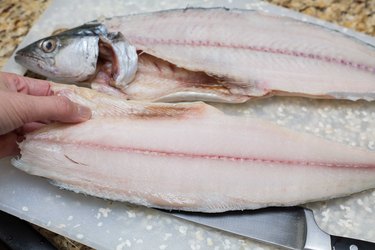
Learning to fillet fish for yourself, rather than leaving it to the staff at your local fishmonger, is a valuable skill for any fish lover. A fish with clear eyes, colorful gills and few missing scales is clearly fresh, but with a processed fillet, it's difficult to know. Furthermore, the freshest fish of all -- the ones you catch yourself -- invariably arrive intact at your cooler. With a sharp knife and a bit of patience, you can quickly learn the fundamentals.
Before You Begin
Video of the Day
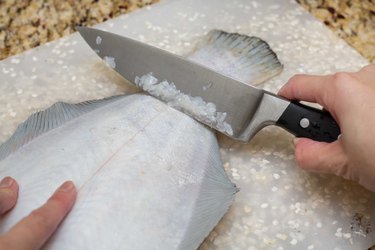
If you like your fillets with the skin on, you'll need to scale the fish before you begin cutting. Scrape from tail to head with a dull knife or the bowl of a tablespoon to remove the scales, then rinse the fish thoroughly under cold water and pat it dry. This is a messy procedure, so it's best to lay down a few sheets of newspaper or a disposable tablecloth to catch the flying scales. Roll up the scale-covered paper and discard it, set out a cutting board and your knife, and you're ready to proceed to the actual filleting.
Video of the Day
Round Fish
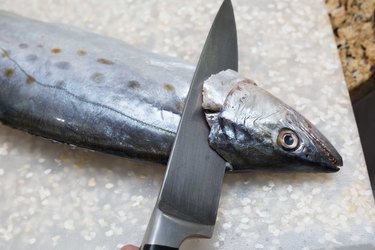
Fish vary widely in their anatomy, but round and flat fish are filleted similarly. Feel behind the gills for the bony plate that gives them their structure. Slide your knife beneath the gill plate, cutting toward the head, to capture as much of that flesh as possible for your fillet. When your blade reaches the backbone, turn it -- or remove it and reinsert it -- so it lays flat, parallel to the backbone, and pointing toward the tail. Draw your knife to the tail in long strokes to free the first fillet. Turn the fish and do the same again on the other side; then cut through the thin tail portions to free the fillets from the carcass.
Flat Fish
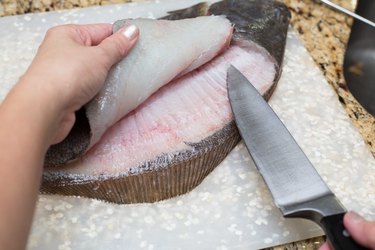
Flat fish such as flounder or sole yield four fillets, rather than two, so the process is slightly different. Slice underneath the gill plate, as you would with a round fish; then gently feel the fish's musculature through the skin. There's a distinct valley where the two fillets meet, marking a natural division in the muscles. Follow this line with your knife, cutting through the skin and down to the backbone. After splitting the fish this way, use the tip of your knife to cut one fillet away from the backbone by an inch or two. Slide your knife blade into this opening and lay it flat; then cut the first fillet away from the spine. Do the same for the second fillet; then turn the fish over and repeat the process for the fillets on the other side.
Finishing Your Fillets
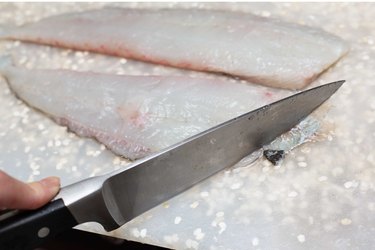
The belly portion of a fillet contains a section of rib bones, held in place by a tough membrane. Slice this away, angling your knife toward the ribs to minimize wasted flesh. Salmon have a row of "pin" bones located above the spine, which can be pulled out with tweezers. Grouper have a line of stiffer bones, which resist pulling and should be cut out. Others, such as walleye and especially shad, are exceedingly bony and require many deft cuts to remove their bones. If you wish to skin the fillets, grasp the thin tail with a paper towel, and angle your knife gently to the skin. Push the knife and pull the fillet, until flesh and skin separate. For skin-on fillets, trim any loose skin or portions of fin for a neater appearance.
A Brief Word on Knives
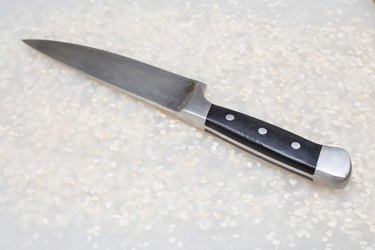
Filleting knifes are very sharp, and they have a narrow blade that passes easily through the fish's delicate flesh. Some prefer a knife with a rigid blade, while others favor one with a modest degree of flex, but this largely boils down to personal preference. The keenness of the blade is crucial, so if you lack the skills to sharpen the knife yourself, have it done regularly by a professional. Skinning large fillets requires a knife long enough to detach the whole skin at a stroke, so you might wish to use a chef's knife or long slicing knife for that task.